


34 Tinker Street
Woodstock, NY 12498

D r a w i n g S o u n d
A n E x h i b i t i o n a n d M u s i c a l P e r f o r m a n c e
o f G r a p h i c S c o r e s

J o G a n t e r
M a r i l y n C r i s p e l l
R a y m o n d M a c D o n a l d






34 Tinker Street
Woodstock, NY 12498

D r a w i n g S o u n d
A n E x h i b i t i o n a n d M u s i c a l P e r f o r m a n c e
o f G r a p h i c S c o r e s

J o G a n t e r
M a r i l y n C r i s p e l l
R a y m o n d M a c D o n a l d


Jo Ganter, Visual Artist
Marilyn Crispell, Piano
Raymond MacDonald, Saxophones
George Burt, Guitar
David Rothenberg, Clarinets and Laptop Electronics
Doug James, Drums
D r a w n g S o u n d
Exh bi ion Dates:
August 25- Oc ober 15, 2017
Loca ion:
The Woods ock Byrdcl f fe Gui d’s
K e ner t/ ames
Cen er or the Ar s
36 T nker S ree , Woods ock, NY
Cura ed by Kerrie Bui rago, Oscar Bu t ago and Me inda St ckney-G bson
Ca a ogue des gn and produc ion by Abiga l Sturges
W o o d s t o c k B y r d c l e G u l d
E x h b o n C o m m i e e M e m b e r s
Byron Bel
Tina Bromberg
Oscar Bu t ago
Paula La a a
Ken Landaue
Ka harine McKenna
Douglas Mi ford
Por ia Munson
Me inda St ckney-G bson
Ka harine Ums ed
Linda We n raub
Sy via Leonard Wo f, Cha r
Ma thew T Leaycraf , Member
Emer tus
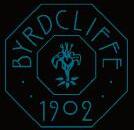
W o o d s t o c k B y r d c l e G u d
B o a d o f D r e c t o r s
Randy Angiel
oseph W Be luck, Counse
Linda Bodner, Treasure
Oscar Bu t ago
Monica Co eman
Frances Halsband
Richard Heppner
ohn Koegel
oan Lonergan, Secreta y
Ka harine McKenna
Ca herine McNea
Erica Obey
Mirav Ozeri
Karen Peters, Vice-Presiden
Ben amin Prosky
Tani Sap rs e n
Abigai Sturges
Lester Wa ker
Paul Wash ngton, Presiden
Sy via Leonard Wo f, Vice-Pres den
Douglas C James, President Emer tus
Garr y Kv s ad, Chairman Emeri us
C a a o g u e S p o n s o s
Kerrie Bui rago
Oscar Bui rago
Doug James
ohn Koegel
Elena Zang Ga ler y
Ar tsys ems
Woods ock Framing Gal er y
Al 2017 Byrdcl f fe ar s programming is made possib e by he
New York S ate Counc l on the Ar s wi h he suppor t o
Governor Andrew Cuomo and he New York Sta e Legisla ure
This project has been suppor ted by the Un ve si y of Edinburgh’s Cha lenge Inves ment Fund and The Hope Scot Trust Fund





J e r e m y A d a m s
K e r r i e B u i t r a g o O s c a r B u i t r a g o M e l i n d a S t i c k n e y - G i b s o n
Curators
The Woodstock Byrdclif fe Gui d s proud to suppor th s pub ication produced for the exhibition Drawing Sound, presen ed in our K einer t/James Center for he Ar s.
One of the original princip es of Byrdc if fe, ounded in 1902, is co laboration Exhibitions such as Draw ng Sound demonstra e how that principle remains alive today Just as the era of industria iza ion led to he establ shment of Byrdc if fe as a p ace that eschewed mass production in favor of the hand-made, Drawing Sound brings he creat ve process, the actual act of making, to the fore Combining musical composition and per formance wi h drawing and prin -making, the exhibi ion’s mu ti-disciplinar y focus is direct y n keeping with our historic iden ity, and our mission to provide a vibran center for exce lence n the ar ts and craf s
Many thanks to the cura ors of his exhibit on, Kerrie Buitrago, Oscar Bu trago, and Melinda S ickney-G bson They have a l worked tirelessly and in harmony o create a thought-provoking exhibition ha we are honored o hos
Many thanks a so to Abigai Sturges for designing his cata ogue Her ser vices and experience have made an elegant an ho ogy of he exhibition Drawing Sound possible
Drawing Sound is an exhibition of graphic scores by Mar lyn Crispe l, a pian st and composer iving n Woodstock, N.Y., Jo Ganter, visual ar t st, and Raymond MacDonald, saxophonist, bo h from Scot and. A key aspec of the exhibition s the engagemen of he ar ists, the musicians and he audience in a unique col aborative experience of looking and istening The ar tis s and musicians worked together to make images to be played whi e the audience p ays a ro e as ac ive par icipan s by istening and reac ing to musical works that can and wi l sound dif ferent each time they are p ayed This is a global exhibit on between Amer ca and Scot and bringing together ar t and music n a un que par nersh p.
Images on he wa l are accompan ed by sound from recordings made from the graphic scores for individua istening The use of headphones permits he l s ener to in eract wi h he work which is both visual and aural o Gan er has a so taken recordings of previous per formances of Running Under Bridges and Gradations of L ght and used the graphic scores to create animated fi ms projected in the space. These animations add another ayer of nterpreta ion between mage and sound as the ar ist imagines how the musicians take the mages and iteral y make them move On the evening of the exhibition’s opening, there wi l be a ive per formance during which the audience wi l be given an image of Manuscript 2 along wi h the ins ructions he musicians wi l use to per form he piece As a resu t of this s mul aneous engagement of looking a what he musicians are p aying and listening o the musicians interpret the graph c image, the audience wi l be an active par ticipant by contribu ing a new dynamic element to the interp ay of
mus c and ar t Marilyn Crispe l on piano, Raymond MacDona d on saxophone, David Rothenberg on c arinet and ap op e ectronics, George Bur t on guitar and Doug James on drums wil give us greater insight into wha the exhibition means through their musica improvisation of the visua mages
Runn ng Under Bridges is the itle of works by the Scot ish col abora ors, MacDonald and Gan er They have co-authored a series of or ginal prints and musical compos tions that test he possibi ities of images as conduc ors of sound, and sound as a compositiona ool or images. In rica e, gr d- ike ma r ces prov de boundaries for blocks o color or tone and crea e emporal structures for the music. Crea ed wi h hand-drawn pencil lines and then scanned or drawn on the computer, hese images move between hand-crafted and digita echniques, without dif ferentiating be ween the wo
Gradations of L ght is a sui e of seven images co-authored by Mari yn Crispe l and Jo Ganter Ganter provided the gr d- ike struc ures while Cr spel crea ed gestura marks and b ocks of one ha score the music. This suite of prints rejec s color in favor of tona va ues. Gradations of Ligh images move from darkest b ack hrough shadowy greys and si ver y, subt e changes of tone, o harsh contras s of black and white Each one is named for a time of day---Morning, M dday, Twi ight, Night which provides a hematic thread hat links he works
Ganter’s grid- ike matrices inform a l of her work with MacDona d and Crispel , bu each musician has a s rong crea ive influence. MacDona d brings brigh color to he
p eces he makes with Gan er. The clear blues, oranges, ye lows and pinks make for bri liant and exuberant abstraction Each piece by Gan er/MacDonald is a new adven ure with dif ferent expressive intent The two series of original prints comp ement each other to produce a varied and or gina exhibition of sound and vision
The v sitor may wonder how this exhibit on and i s juxtaposi ion of images and sound came nto being. David Rothenberg, in his br ll ant essay on mprovisation and the image, demons rates how the long histor y of graphic no ation evolved over ime In addi ion, the scores on display n the gal er y will give the viewer a glimpse of a few composers whose notations, both traditional and non-conventiona , are visua representations of the inter twining of music and ar t To see a po yphon c score by J S Bach, who was arguab y he greatest improv ser of the Baroque era, and compare i wi h the John Cage score of 4'33" which was premiered at the Maver ck Concer Hal in Woods ock n 1952, we can see that much has changed Bach, who never traveled far beyond Leipzig, composed music fil ed with notes o be p ayed by keyboard masters On the o her hand, John Cage (not a keyboard master), spen time in faraway places such as India and embraced minimalism in his score, which includes writ en ins ructions n place of rad tiona notation: the environment and its acc dental sounds are what “ p ay ” the music.
If we s udy he piece done by Doug Navarra in 2013 that super mposes a minima ist interpre ation on a handwrit en music book from the 18th centur y, we come to he conclusion that ar t and music are indeed inter twined and the past s in our present The complex notation of Gyorgy Ligeti and George Crumb has produced composit ons that are masterp eces visua ly speaking and hardly what is considered raditiona notation. Un ike Jo Gan er ’ s abstrac imager y which invi es the per former to play he role of composer by playing the piece in a d f eren way each ime, L geti and Crumb intend for the per former to play he work similarly each t me, bu as with any per formance piece, this is clear y an impossibili y
On disp ay is he graphic score ca led Fel Even s by Raymond MacDona d and I ana Halperin which explores re a ionships between geological events and socia relationships using saxophone, voice, drums, doub e bass, French horn, graphic scores and improvisation
Barr y Guy, an innovative British composer and double bass p ayer s known for his creativity in jazz improv sation. He has shared with us one of his graphic scores, Bird Gong Game, in which performers can experiment with improvisation echniques.
Graphic images de ight the viewer and expand he boundaries of the visua -sound p ane but no a ion in he traditiona sense has no disappeared from view, and the use of graphic no at on is not meant to rep ace rad tional no at on Kenda l
Dure le Briggs is a contemporar y American composer and au hor whose know edge of harmony s without rival. His high y original compositions have ens ons and resolutions which can be somewha d ssonant but his mus c reaches a broad audience as i is readi y accessible on so many leve s
On disp ay is his Symphony # 2, and also he ske ch of a work called Sonatine, a charming, exhuberant composi ion for piano four hands dedicated to one o his studen s Briggs descr bes his work as “based upon the craft ng of independent elements of melody, rhythm and harmony Each is reated independent y so hat they may be combined together, bu struc ure is decided first and he res is pure decoration ”
Also in the display case the viewer wi l see a piece by Peter Schicke e who s perhaps be ter known as the witty, satiric composer P D Q Bach, whose parodies of Baroque and Classical music defy conven ional scholarship This it le surprise piece using conven ional notation is enti led Wal z or Elena and is bo h a ribu e to friendship and a demonstration of his personal and more serious side. t s in eres ing to ake a look at works by composers like Peter Schickele and Kenda l Dure le Briggs who are carr ying on a classical tradition of no a ion whi e other composers have sough to re inquish
traditional no at on for abstraction and improv sat on. Bo h are valid and are par of our rich mus ca heritage celebrating ar t and music
A look at the score of gor S ravinsky’s Ri e of Spring makes us bel eve he reviewers who said hat musicians had never seen no ation like that before We know from reviews of the opening nigh that the audience reacted strongly, compla ning abou almost ever y hing, especial y hat Stravinsky pushed the orchestra to ex remes. The score ells the s or y of complex rhythms with simple fo ksong melody taking a back sea The ntense irregular, pulsating rhythms he wanted forced S ravinsky to come up wi h innovations in musical notation so that he grea ly enlarged orchestra could p ay them
Musicians in he exhibition, Mar lyn Crispel and Raymond MacDona d, have had a different experience even hough members of he audience had probably never heard music like t before. When they p ayed Long ng toge her, a reviewer ca led he experience “ an awareness that you ’ re in the presence of something spec a ” Audiences have come to welcome new exper ences n he sound as we l as the visual realms
Anthony Brax on, a saxophon s who has played wi h Mari yn Cr spel in the pas , and a so per formed in Woods ock at the Jazz Fes ival in 1981, describes his music as “ crea ive music,” of en using puzzling diagrams which func ion as musical no ation giving the per former clues as o how to play the music He a so uses conceptual innovations in his musical systems For example, Fall ing River Music explores logic construct “paintings” as the score ’ s music no ation wi h Brax on wanting he per former o find his/her way He says “I am par icular y interes ed in th s d rec ion as a means o balance the demands of radi ional no ation nterpreta ion.”
Composers have embraced ever y instrument and noninstrument, including iPads and other e ectronics, and many o her unusual ob ects, for the purpose of making mus c and have expressed ideas ranging from abstrac philosophica
concep s dealing wi h space and silence to down- o-ear th geological phenomena n the final analys s, this exhibition is about crea ing a dialogue be ween ar t st, per former and audience The Draw ng Sound composers and ar tis s make a compelling argument ha , while we canno escape our past, we can build on i in our continuing search for origina expressive possibili ies of connec ing drawing and sound As Nadia Bou anger once said, “There is no con rad ction between radition and innovation.”
Like a l exhibitions, Drawing Sound wou d no have been possible without the extraordinar y suppor t o many people: he sponsors, lenders, and especial y the ar ists and musicians from Scotland We are grateful o them for working so c ose y wi h us to realize the vision of Drawing Sound Thank you a so o Dav d Ro henberg who not only joined the musicians but contributed o our unders anding of graphic images in his essay on improvisation and the image. We are a so grea ly indeb ed to Sneha Kapadia of he Woodstock Framing Galler y (WFG) for assis ing us with our framing We a so wan o thank Kendall Durelle Briggs, a composer and professor of harmony at The uil iard Schoo for his insight into he se ection of scores o display as reference A big thank you a so to Chris Andersen of Nevessa Studios who worked wi h Mari yn Crispe l to ins a l the sound for he images, which made the sound/visua col aboration make sense o the viewer. We want to give special thanks to Derin Tanyo and the Exhibition Comm ttee who guided us along the pa h of cura ing an exhibition and o Jeremy Adams, the Executive Director of the Woods ock Byrdc if fe Gui d and the Board of Direc ors for ful y suppor ting our ef for s o bring his groundbreaking exhibi ion to the Kleiner t/James Cen er for the Ar ts And, we also want to thank Abigail S urges for her invaluable sugges ions and help on he pub ication of the catalogue. f he purpose of Drawing Sound is to introduce a new perspective on he in ersec ion of ar and music as we l as cha lenge and inspire us o welcome new experiences, then the exhibition has realized its goals
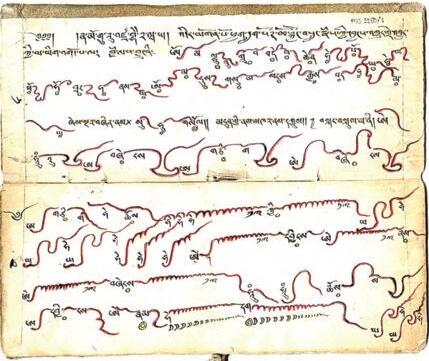
Composing music. Per forming music. Listening to music What could these hree poss bly have o do with one another?” wro e John Cage in Silence I have a ways wondered wha th s koan-like s atemen could mean, and after years of perp exity I think ha it has some hing to do with how dif ficu t it s to get others o play for us the sounds we wan to hear That is clearly why musical notation was first inven ed, and as ef ficient and prec se as the system of visual shapes and ins ructions has become to trans ate ideas in o sound, there is a way in which we have never been happy with it Wha if we don’t know exac ly what we wan o hear, bu we want to direct these musicians to do some hing tha o her wise they would be unable to do?
This is why no at on somet mes becomes so creative Al hough at first it was suggestive or mnemonic, no es to he p us o remember wha we need to each ora ly. Or s range inscrutable lines and codes o bring for th the possible sounds inside musicians that they never knew were there For most of music’s housands of years of presence in human life, i was some hing ora ly taught from one person to ano her, and shared and invented in groups There was always composition, and always improv sation, sounds organized and made a ive on the spot
The ear iest notation showed the shape and flow of sounds over time as shaped, wavering cur ves. This sur vives up to he present in T betan musical no a ion, which has a ways showed the ways one is mean to nflect the sacred syl ab es, not precisely wha notes o sing (1 ) n Medieval times, when Chr stian monks were chanting in ways somewhat similar to

wha Tibetan monks were doing, ones star ted to get f xed in terms of pitch The f owing ines, cal ed ‘ neumes, ’ evo ved into the specific notes we hink o as standard mus ca nota ion today (2 Over the hundreds of years fol owing we go musical staves, key signatures, time s gna ures, dynamic markings, and al kinds of standardiza ion of no a ion, so that today a trained musician can sit down and p ay a complex piece immedia e y from the page having never seen t before. Wha an amazing abi ity to synchronize human behavior with symbo s, ines, and rules on the page Mus cal nota ion’s success is truly remarkab e
So why hen did John Cage and his contemporaries s ar t o question it, and pu for h abstract ines and images on musical scores and say o sight-read ng musicians, “okay, now it’s t me for you o p ay this”? It was he grea success o musical no at on tha ed composers to cal i in o question. Because i was working so well, musicians were star ting o become l ke se fdriving cars, itt e machines that cou d look at a page and almost automa ica ly turn notes into mus c, without even th nking What wou d happen if they star ed think ng? Cou d they make unexpec ed music ha no one had planned or heard before, sounds invented purely in the si ua ion, conjured up out of uncer tainty and surprise interac ion?
3 John Cage g aphic score Imag nar y Landscape no X
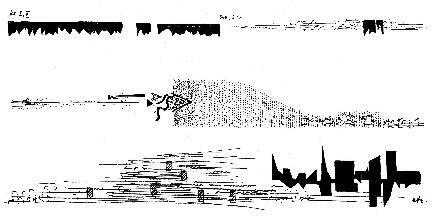
Modern classica composition was par t of a questioning of assump ions tha appeared n a l the ar s in the wentieth centur y. Pa nters no longer wanting to represent real and visib e things, dramatists writing p ays with no stor y and no p o , architec s building bui dings wi h no inside or outside, ever ything seemed up in the air Graphic nota ion appeared a most overnigh , unsuspec edly beauti ul, and puzz ed musicreaders were sudden y se free
Or the who e hing might be about something e se: Improvisat on had gone ou of classical music. Even those freewhee ing cadenzas so be oved of Mozar and Liszt were now exac ly notated on he page. You were supposed to p ay just wha was there Graphic no a ion, with its al usions o the ancient roots of musica no ation’s suggest ve rather than defin tive quali y became a kind of creative prodding for t gh ly-wound musicians to let loose Here’s the notation, new symbols you have never seen before We composers w ll not te l you what they mean, so you have to figure it out on your own There’s a whole group
of you, no conduc or f his won ’ make you improvise then nothing wil (3) The ten a ive roughness here is part of i s va ue It’s as if we see someone confron ing th s thing ‘ mus c ’ for the first time and tr ying to ske ch it down o explain it to someone who migh be unable to hear t bu wants to recreate it
In response o Cage the British composer Corne ius Cardew made graphic no ation nto a radica pol tical act n the pages of his long co lection of image-instruc ions, Trea ise, Cardew put for th a long, winding score as a visua manifesto, a cal o arms o rejec the system, chal enge author ty, and create an anti-au horitar an pic ure of how music could be. An anarchist ensemble, the Scratch Orches ra, with no leader, makes music spontaneous y oge her out of crazy images and w ld ideas! Cardew urns his back on the musica staf f, which lies empty a the bottom of the page, whi e hallucina ions of musica organ zat on sw r above on the image, and presumab y inside the mind and into he hands of he per former (4 ) You figure it out!
4 Cornel us Cardew graphic score, from Trea ise

Now wai a second, you hink, what are a l these composers going on abou ? Hasn’t music been made like this without scores for housands of years. Isn’ this wha improvisation is, and are there not dif feren kinds of musicians who are comp e ely comfor table making sounds oge her this way without a l his surrea istic imager y? Cardew after a whi e hought he same thing:
One can say of a “free improvising” mus cian that he uses the world as a directive And of Indian musicians or jazz musicians that they use establ shed, orally transmitted norms such as specific modes or he 12 bar blues as directives in heir music-making. A though these things direct such a musician in his p aying, he does not have o read them The wri ten directive is he characteristic developmen that led to he separation out of the composer as a distinc type of musician; as one who works wi h his head and hence dominan (in bourgeois society) over hose who work with their hands (the players)
The composer of graphic mus c sets himself against this separation, bu only succeeds in heightening it How? By composing graphica ly he ries to reappropr ate a manual ro e; he no longer jus writes, he develops graphic ski ls. Bu in liberating the p ayer from he domination of he written score, he l berates himself from the activity of music making
Cardew decided his whole approach was a failure; a l these wi d images got in he way of actual, collec ive, democra ic mus c. It’s ike when Dustin Ho fman to d Laurence Olivier he had stayed up or hree days withou sleep to rea ly get into character, and O ivier said, “My dear boy, why not just tr y acting?” Why no jus tr y improvising and hrow away the inscru able score! Why not just tr y making music with no clear plan, no guide on the page Ah, tha means you become a dif ferent k nd of musician Or maybe we all can be that kind of musician: i ’ s in us, and it’s go o come ou
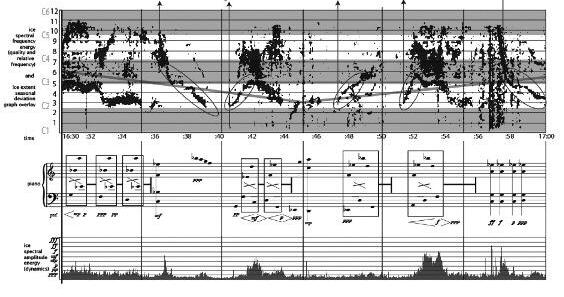

Jo Ganter’s beautifu graphic scores are ins ructions for improvisat ons per ormed by Marilyn Crispe l, Raymond MacDona d, and myse f. All of us have improvised plenty with jazz char ts, chord changes, and often no preordained instruc ions at a l If he were a ive today I wou d say to Cardew, “Cornel us, do not fre A l your work was no for naught You taught some people to be freer than they could other wise be And what could be more radical than that?”
Some commentators on this topic say graphic scores are passé, hat they are an ar ifac of an ear ier period when composers were kind of bourgeois and desperate to get loose But not ever yone fee s that way The con emporar y composer Matthew Bur tner writes e abora e operas and ha felectronic ensemble works often on environmenta themes He ranslates c oud pa terns and wea her data into mages for musicians to precisely per form (5 ) When I o d him his scores were beautifu , he said, “Tha ’ s no he point The reason I make these scores is this is he only way I know how to get musicians o do exact y what want.” Now this is a composer who truly be ieves n his method
We al want he music we write, play, or l sten o to be tota and transforma ive These ac ivi ies do have ever ything to do with one ano her, and o d Zen master Cage cer tainly knew that; he’s smiling at us from all around the ver y ma ter of mus c that sur vives Musica nota ion wil never con ain al he music we imagine, p ay, or hear. The graphic can grasp for tha which cannot be explained or defined. So maybe my favorite example of graphic notation is Yehudi Menuhin’s heavi y annota ed page of a Bach so o violin sonata (6 ) He has scrawled a l over the original score to sugges dif erent fingerings and ways of realizing the work, this over a lifet me where this grea violinis had to confront this work so many imes The best music is so much more than any one per formance or image, and i swirls from nside our heads and out to the worlds in an eternal scrawling uns oppab e line…
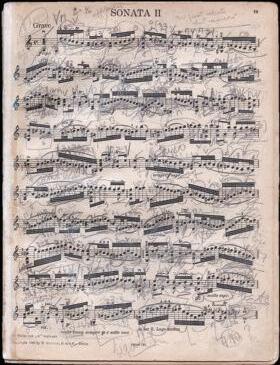
6 Yehudi Menuhin’s heav ly anno ated copy of Bach’s Sonata I or solo v o in


TITLE PAGE 2016
A chival ink e print
19 7 x 13"
BEFORE DAWN 2016
Archiva inkje print
19 7 x 13"
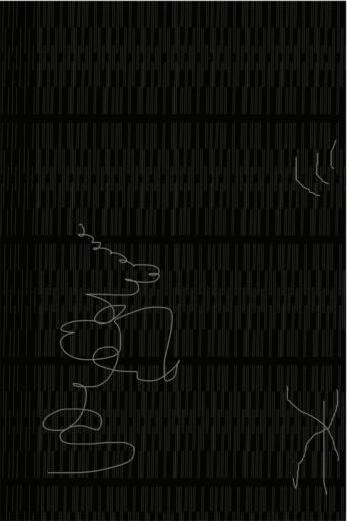

DAWN 2016
MORNING 2016
19 7 x 13"
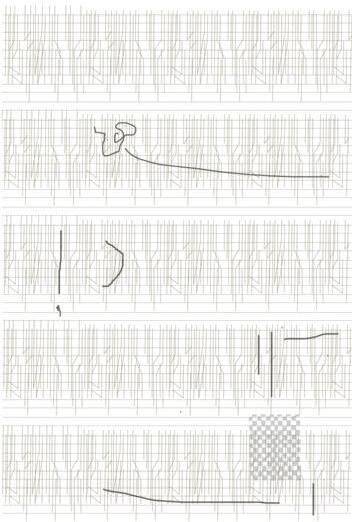
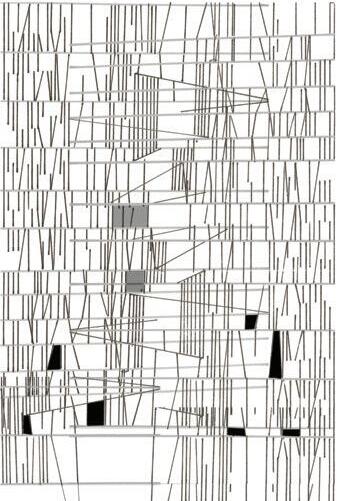
MIDDAY 2016
Archiva ink e print
19 7 x 13"
AFTERNOON 2016
A chival nk e print
19 7 x 13"
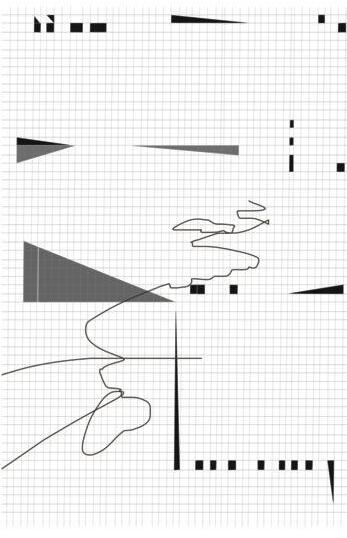
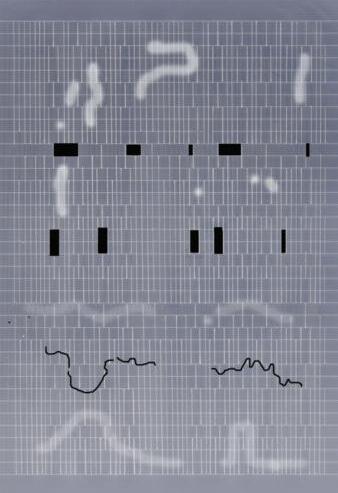
TWIL GHT 2016
N GHT 2016
A chival nk e print
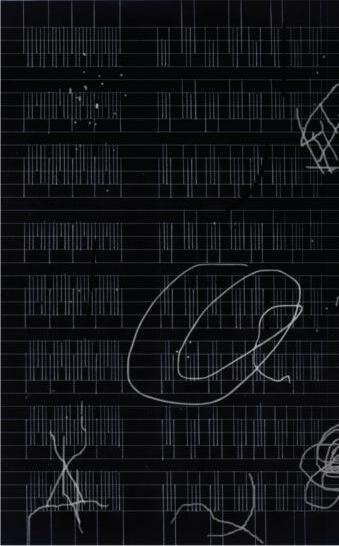

W O R K S B Y
J
11AM 2016
Archiva inkje print
59 x 39
CURVE (DARK TO L GHT 2017
Achiva ink e print
19 7 x 15 5"
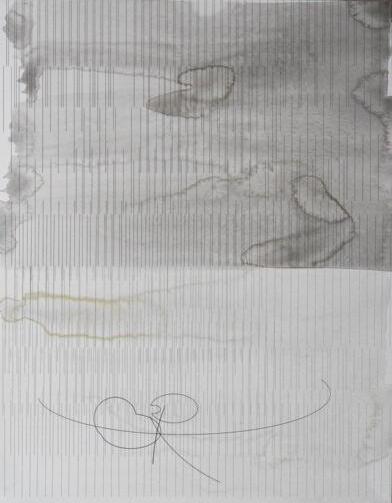

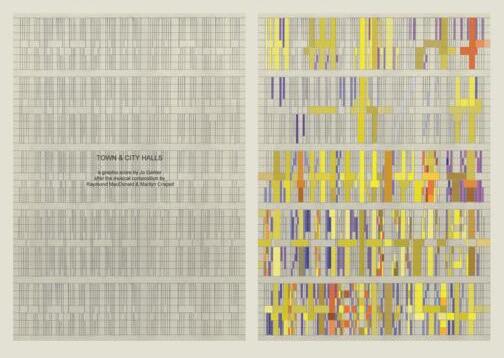
Af er he musica composi ion by Raymond MacDona d and Mari yn Cr spel
LONGING
CONVERSAT ON
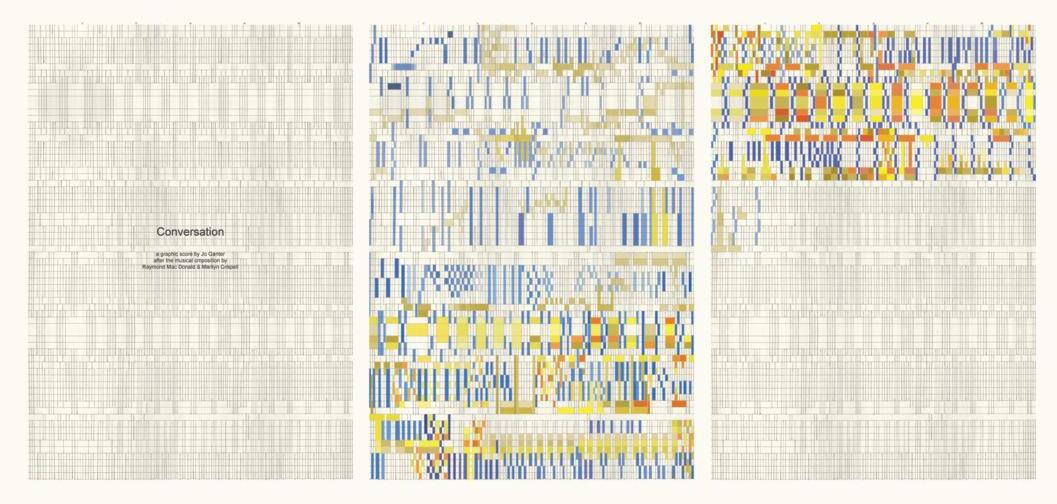
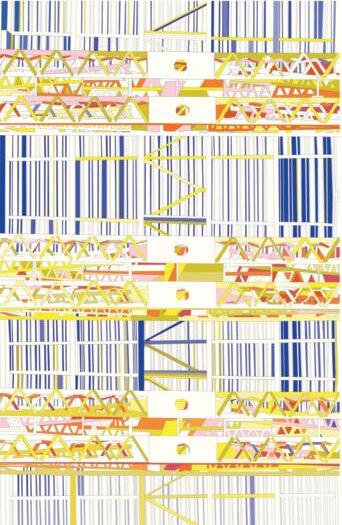
W O R K S B Y
RUNN NG UNDER BR DGES
2016
Archiva inkjet print
59 x 39
BLUE 2017
A chival nk e print
18 x 13"
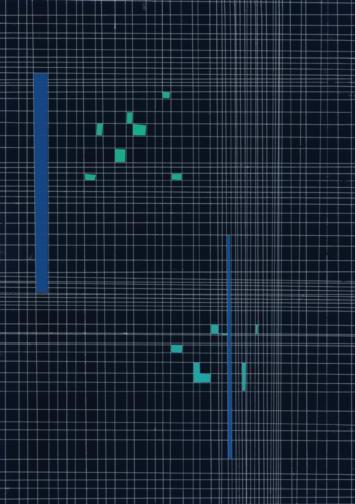

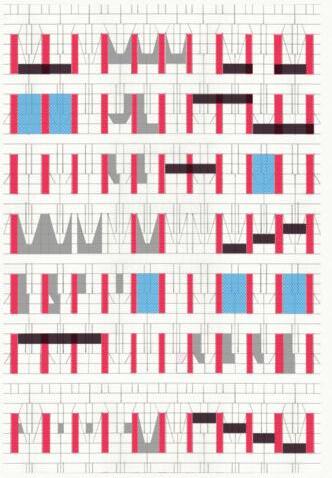
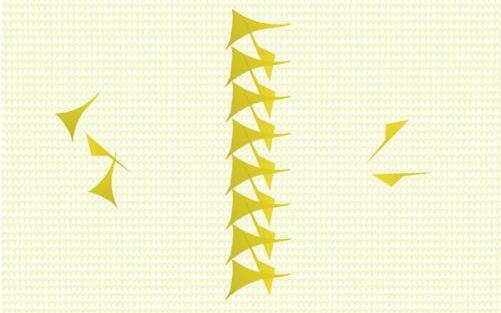
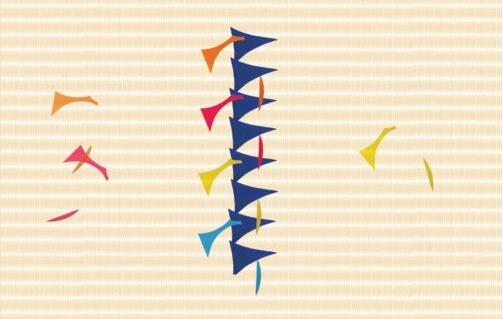
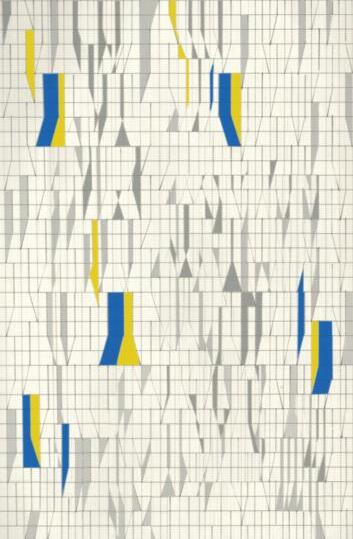

P A G E 3
D o u g N a v a r r a
UNT TLED
2013
Gouache, penci & ink on found paper
13 x 15 5"
Pr vate Co lec ion
G R A D AT I O N S O F L I G H T
J o G a n t e r a n d M a r y n C r i s p e l
T TLE PAGE
2016
Arch va inkjet pr n
19 7 x 13”
BEFORE DAWN
2016
Arch va inkjet pr n
19 7 x 13"
DAWN
2016
Arch va inkjet pr n
19 7 x 14”
MORN NG
2016
Arch va inkjet pr n
19 7 x 13”
M DDAY
2016
Arch va inkjet pr n
19 7 x 13”
AFTERNOON
2016
Arch va inkjet pr n
19 7 x 13”
TWILIGHT
2016
Arch va nkje pr n
19.7 x 13”
N GHT
2016
Arch va nkje pr n
19 7 x 12 7”
W O R K S B Y
J o G a n t e r a n d M a r l y n C r i s p e l
11 AM
2016
Arch va nkje pr n
59 x 39"
CURVE (DARK TO LIGHT)
2017
Ach val nk e pr n
19 7 x 15 5"
P A R A L L E L M O M E N T S S E R E S J o G a n t e r
Af er he mus ca composi ion by Raymond MacDona d and Mari yn Cr spe l
LONGING
2015
Arch va nkje pr n
18 x 27 7"
CONVERSAT ON
2015
Arch va nkje pr n
18 x 38 6"
TOWN AND C TY HALLS
2015
Arch va nkje pr n 18 x 26"
W O R K S B Y
J o G a n t e r a n d R a y m o n d M a c D o n a l d
RUNNING UNDER BRIDGES
2016
Arch val nk e pr n
59 x 39"
MANUSCR PT
2016
Arch val nk e pr n
19 x 15"
MANUSCR PT 2
2017
Arch val nk e pr n
19 x 15"
BLUE FUGUE
2017
Arch val nk e pr n
40 x 63"
YELLOW FUGUE
2017
Arch val nk e pr n
40 x 63"
SLANT 2
2017
Arch val nk e pr n
19 x 14 7"
BLUE
2017
Arch val nk e pr n
18 x 13"
GEOMETR C ISOLAT ONS
2017
Arch val nk e pr n
19 7 x 14"
J o h a n n S e b a s t a n B a c h
WELL-TEMPERED CLAV ER
Cour tesy o Kenda l Dure le Briggs
A n h o n y B r a x t o n
FALL NG R VER MUS C
Cour tesy o Tri-Cen ric Foundat on
K e n d a D u r e l e B r i g g s
SYMPHONY #2
SONAT NE FOR P ANO 4 HANDS
Cour tesy o he ar ist
G e o r g e B u r t
IMPROCERTO
Cour tesy o he ar ist
J o h n C a g e
4 33
Cour tesy o Kenda l Dure le Briggs
B a r r y G u y
BIRD GONG GAME
Cour tesy o he ar ist
G y o r g y L i g e t
PIANO ETUDES
Cour tesy o Kenda l Dure le Briggs
R a y m o n d M a c D o n a d & I l a n a H a p e r i n
FELT EVENTS
Cour tesy o he ar ists
R M u r r a y S c h a f e r
SNOW FORMS
Cour tesy o Dav d Rothenberg
P e t e r S c h c k e l e
WALTZ FOR ELENA
Cour tesy o E ena Zang Ga er y
E i o t t S h a r p
HUDSON R VER NR 6
Cour tesy o he ar ist
I g o r S a v n s k y
R TE OF SPR NG
Cour tesy o Kenda l Dure le Briggs
Resources for Further Study
O n i n e
ht p://scoresimp ovisat ons ex s b ogspo com/ ht ps://l l l co/ /experimen a -music-nota ion-resources/149/42 ht ps://www pinteres com/b rec use /musica -graphic-nota ion /? p= rue
B o o k s
ohn Cage, No at ons ht ps://monoskop org/Fi e: ohn Cage Notations 1969 pdf
Co nel us Cardew, Trea ise ht ps://monoskop org/Fi e:Ca dew Corne ius Trea ise 1967 pdf
Wadada Leo Smi h, The Language Scores ht p://www renaissancesoc e y o g/exh bi ions/4/wadada- eosmi h-ankhrasma ion- he-language-scores-1967-2015/
Theresa Sauer, No at ons 21 Brook yn: Mark Bat y Pub isher, 2009
O n i n e
ht p://www newmus cbox org/ar icles/ nside-No at ons-21/ ht ps://www brainp ck ngs org/2011/05/06/no at ons-21/ ht ps://www thegua dian com/music/gal er y/2013/oct/04/ graph c-music-scores-in-p ctures
S rav nsky’s Ri e o Spr ng v sua ized: ht ps://www you ube com/wa ch?v=02 kp6eeh40
Chop n Fan aisie- mpromptu Opus 66: ht ps://www you ube com/wa ch?v=APQ2RKECMW8
Lige i, Ar iku a ion: ht ps://www you ube com/wa ch?v=71hN skTZQ
Lige i, Volum na: ht ps://www you ube com/wa ch?v=wbLc 9- s0U
G r a p h i c s c o r e - r e a e d I O S a p p s
TC-11 syn hes zer
ht p://www b tshapesof ware com/instrumen s/tc-11/
Kenneth Kirschner and oshua O t apps
ht ps://i unes app e com/us/deve oper/inter val-s udios/id364824624
Br an Eno genera ive apps
ht ps://i unes app e com/us/app/b oom/ d292792586?m =8
Jo Ganter is a visual artist, printmaker and Lecturer in Fine Art at the University of Edinburgh. She has won many awards for her work, including a Rome Scholarship. In 2003 Ganter was elected to the Royal Scottish Academy of Art and Architecture. She has exhibited internationally, showing at the A.I.R. Gallery in New York in 2000 and winning the Canson Polska Award at the Cracow Print Triennial in 2012. Her work is included in many major collections, including The Museum of Fine Arts, Antwerp and the New York Public Library.
Marilyn Crispell has been a composer and performer of contemporary improvised music since 1978. For ten years, she was a member of the Anthony Braxton Quartet and the Reggie Workman Ensemble, and she has performed and recorded extensively as a soloist and with players on the American and international jazz scene, also working with dancers, poets, film-makers and visual artists, and teaching workshops in improvisation. She has been the recipient of three New York Foundation for the Arts Fellowships, a Guggenheim Fellowship, and a Mary Flagler Cary Charitable Trust composition commission.
Raymond MacDonald is a saxophonist and composer who has released over 50 CDs and toured and broadcast worldwide. He has written music for film, television, theatre, radio and art installations and much of his work explores the boundaries and ambiguities between what is conventionally seen as improvisation and composition. He has collaborated with musicians such as Marilyn Crispell, George Lewis, Evan Parker, David Byrne and Jim O’Rourke and his work is informed by a view of improvisation as a social, collaborative and uniquely creative process that provides opportunities to develop new ways of working musically. He plays in many collaborative free improvisatory contexts and his roots in jazz and pop music can also be heard in his playing and writing. He is also Professor of Music Psychology and Improvisation at Edinburgh University and lectures, publishes and runs workshops internationally.
George Burt is a guitarist and composer based in Falkirk, Scotland. Early experience includes playing in folk groups, ceilidh bands, pit bands, and mainstream and modern jazz groups. He ran a series of improvisation workshops in the 1990s, and this eventually led to the formation of the George Burt/Raymond MacDonald Quartet (BMacD). The group was described by the Penguin Guide to Jazz as the leading partnership on the modern/free scene in Scotland, making impressive international associations. These included Harry Beckett, Keith Tippett and Lol Coxhill. The group’s crowning achievement is a pair of concept albums celebrating the lives of the Victorian traveller Isabella Bird and her sister Henrietta. He has been lucky enough to perform with a number of his favorite musicians;
Barry Guy, Marilyn Crispell, Julie Tippetts and Mat Maneri, as well as his two favorite guitarists, Susan Alcorn and Bill Wells.
Musician and philosopher David Rothenberg has performed and recorded on clarinet with Pauline Oliveros, Peter Gabriel, Ray Phiri, Suzanne Vega, Scanner, Glen Velez, Elliot Sharp, Markus Reuter, and the Karnataka College of Percussion. Most of his work has an environmental theme and involves the sounds of nature, live and in the studio. He has sixteen CDs out under his own name, including On the Cliffs of the Heart, named one of the top ten releases of 1995 by Jazz Magazine and One Dark Night Left My Silent House, a duet album on ECM with pianist Marilyn Crispell, called “une petite miracle” by Le Monde and named by The Village Voice one of the ten best CDs of 2010. Rothenberg is the author of Why Birds Sing, book and CD, published in seven languages and the subject of a BBC television documentary. He is also the author of numerous other books on music, art, and nature, including Thousand Mile Song, about making music with whales, and Survival of the Beautiful, about aesthetics in evolution. His book and CD Bug Music, featuring the sounds of the entomological world, has been featured on PBS News Hour and in the New Yorker. His latest recordings are Cicada Dream Band, Cool Spring and Berlin Bülbül. Rothenberg is Distinguished Professor of Philosophy and Music at the New Jersey Institute of Technology. ww.davidrothenberg.net.
Doug James has been playing the drums since he was ten and first recorded with a University of Wisconsin jazz band when he was 14. He recorded nine albums with The Sons of Bix, a band that dates to the 1920s and over the years featured Eddie Condon, Red Nichols, Bobby Hackett, and an early singer/actor named Jimmy Stewart. One of these was Bob Haggart’s Portrait of Bix for the Jazzology label. He has recorded with John Simon, Paul Butterfield, Happy Traum, John Sebastian, Blood Sweat and Tears, Al Kooper, David Sanborn, Geoff Muldaur, Homesick James, Warren Vache, and Bucky Pizzarelli. He made two CDs with Marilyn Crispell: And Your Ivory Voice Sings (1985) and Gaia (1987) with Reggie Workman—both for Leo Records. Sounds Like Magazine in its review of the first album said, “Doug James's drumming is more than supportive, it's an integral part of the proceedings. James and Crispell have built an impressisve understanding of each piece's and each other's direction and possibilities,” and Jazz Times said, “James makes an ideal rhythm partner, adept, responsive yet robust where it is necessary.” He credits Buddy Rich and Jack DeJohnette as teachers.
